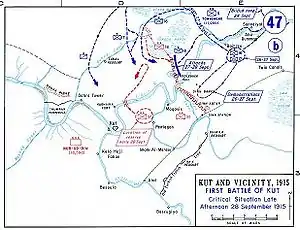
Major-General Sir Patrick Hehir KCIE CB CMG FRSE FRCPE FRCSE (17 May 1859 – 1 May 1937) was a British military surgeon. He served in the Indian Medical Service (IMS) and as the Principal Medical Officer to the army of the Nizam of Hyderabad. During the 148 day Siege of Kut he suffered alongside the troops and wrote extensively on the topic of prolonged starvation.
Life
He was born on 17 May 1859, the son of Robert Martin Hehir of Ennis in County Clare, Ireland.
He studied at Calcutta University, qualified as a doctor in Brussels's, became a Licentiate of the Royal College of Surgeons and the Royal College of Physicians at the University of Edinburgh, obtained a Diploma in Public Health from the University of Cambridge and then received a Diploma in Tropical Medicine from the University of Liverpool.[1]
In 1893 he was elected a Fellow of the Royal Society of Edinburgh. His proposers were Patrick Doyle, Sir Joseph Fayrer, Sir Byrom Bramwell and Thomas Annandale.[2]
During his years in India he appears to have become an opium addict. Back in Britain, when this was made illegal in 1894, he wrote he rued not being addicted to legal activities.[3]
He saw active service in many military campaigns and was highly decorated. In the First World War he served in Mesopotamia as the Principal Medical Officer. He was present at the Battle of Ctesiphon and the ill-fated Siege of Kut under General Charles Townshend.[1] He was captured when the garrison surrendered on 29 April 1916 but was released 25 September 1916.[4] He went on to see service in Waziristan in 1917 and lastly Afghanistan (1919).[5]
He retired 9 December 1919.[1]
He died on 1 May 1937.

Honours
See[5]
- Companion of the Order of the Bath (CB)
- Companion of the Order of St Michael and St George (CMG)
- Knight Commander of Order of the Indian Empire (KCIE)
- Knight of Grace of the Order of St John of Jerusalem
- Campaign Medal, Burma 1886–1887
- Campaign Medal, North-West Frontier 1897–1898
- Campaign Medal, North-West Frontier 1908, Afghanistan NWF 1919
Publications
- Outlines of Medical Jurisprudence for India (1892)
- The Medical Profession in India (1923)
- Malaria in India (1927)
Family
In 1908 he married Dora Lloyd and together they one daughter.[6]
References
- 1 2 3 Roll of the Indian Medical Service 1615–1930 by D. G. Crawford, pages 208 & 209
- ↑ Biographical Index of Former Fellows of the Royal Society of Edinburgh 1783–2002 (PDF). The Royal Society of Edinburgh. July 2006. ISBN 0-902-198-84-X.
- ↑ Opium for the Masses, Jim Hogshire, p.41
- ↑ List of British Officers taken prisoner in the various Theatres of War between August, 1914, and November 1918 by Cox & Co.
- 1 2 m'k, A. G. "Sir Patrick Hehir, C.B., C.M.G., K.C.I.E., M.D., D.T.M., F.R.C.P.E., F.R.C.S.E., Major-General, I.M.S., Knight of Grace of the Order of St John of Jerusalem | Proceedings of the Royal Society of Edinburgh | Cambridge Core". Proceedings of the Royal Society of Edinburgh. 57: 416. doi:10.1017/S0370164600013961. Retrieved 10 April 2018.
- ↑ Who's Who, 1935